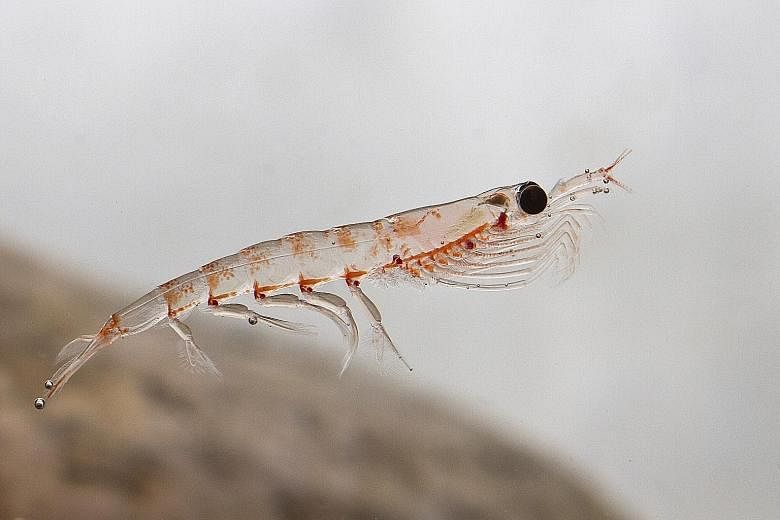On an August morning aboard the Nathaniel B. Palmer research vessel floating at the bottom of the world, Dr Christian Reiss was listening for acoustic signals bouncing off krill, a pinkish, feathery-limbed crustacean that is the lifeblood of the Antarctic ecosystem.
It was the last month of the Southern Hemisphere winter, and conditions were good: There was no thud from sea ice pancakes bumping together to distort his tests in the clear waters of the South Shetland Islands, about 800km south of Cape Horn.
Dr Reiss, an oceanographer with the US National Oceanic and Atmospheric Administration, and his team were studying where krill live in winter.
Low levels of sea ice gave them access to bays that in previous winters were closed. They wanted to know if a lack of sea ice, where krill gather to feed off the algae that live on the underside, was threatening the ocean's largest biomass. Krill form schools that can be miles long and deep.
Whales, sea birds, penguins, squid and seals all feed off krill. And they compete with commercial fisheries, which sell the tiny creatures to be used as fish food or to make omega-3 fish oil for human use.
Dr Reiss' findings are crucial. Two hundred and fifty scientists and policymakers are gathered in Hobart, Tasmania, for an annual conference on managing marine life in the Antarctic, including how to preserve the krill population.
Dr Reiss' five winter expeditions to the Antarctic showed that large numbers of krill remain in the open sea, in areas where fishing companies trawl for them.
At issue for scientists and policymakers is a measure that limits how much krill large commercial trawlers can vacuum from each of four designated zones of the South Atlantic.
The rule, known as Conservation Measure 51-07, expires next month. It forces fishing companies to spread their fishing activity across larger areas to reduce the impact in any one zone.
Without it, penguins, sea birds, whales and other animals that feed on krill around the Antarctic Peninsula will be at risk of undernourishment or starvation.
"There is bound to be a thorough debate," Dr Reiss said in a telephone call from Hobart. "Fisheries want to take all their catch from areas where they already fish. They don't want to take it from areas where they don't fish. That's the opposite of being precautionary."
The Commission for the Conservation of Antarctic Marine Living Resources is made up of the European Union and 24 other nations that have economic or research interests in the Antarctic.
The commission regulates fishing near Antarctica and works by consensus. If one country blocks a measure, it fails. Last year, Russia blocked a proposal for two huge marine parks, each larger than Texas. Those parks, and a third, are back on the agenda during two weeks of meetings, which began on Monday.
The Antarctic has long been an area of dispute for conservationists and commercial fishing interests. Last year, 12 fishing vessels caught 225,466 tonnes of krill in three of the designated areas around the Bransfield Strait. "We know the fisheries like to concentrate here," said Ms Andrea Kavanagh, a director of the Southern Ocean Sanctuaries Campaign at Pew Charitable Trusts.
During the 1970s and 1980s, more fishing took place off the east coast, when the Soviet Union trawled Antarctic waters. But fishing off the Antarctic Peninsula is more profitable. It is close to Chile and more easily accessible, and the weather permits fishing almost all year round.
"We need to do a lot more to manage fishing," she said, noting that krill are the mainstay of the diet of two threatened penguin species, the chinstrap and the Adelie.
Scientists estimate there could be as many as 60 million tonnes of krill in the South Atlantic, between the tiny island of South Georgia and the Antarctic Peninsula.
None says the krill harvest threatens the survival of the species. The Antarctic conservation commission limits the catch to 620,000 tonnes in a zone, and then fishing stops. The limit for total krill catch in the Scotia Sea, which lies between the tip of South America and the far reaches of the Antarctic Peninsula, is 5.6 million tonnes. Most fishing is concentrated in very small zones.
Dr Reiss said estimates for krill biomass are based on summer surveys, but data is scant in winter, when fishing is increased. His five winter expeditions to the Antarctic revealed surprising numbers of krill in the Bransfield Strait, where this year there was almost no sea ice.
"When there's an absolute lack of sea ice, that's a triple threat," Dr Reiss said.
"There's no food for the krill to eat and grow, there's little protection from predators because the krill can't hide in sea-ice niches, and there's no physical habitat to keep them anchored and stop strong currents from taking them away."
Scientists do not know enough to understand natural krill mortality rates at winter's end, but they worry fishing could harm krill populations in concentrated fishing zones and rob natural predators of food.
A paucity of winter research has left scientists wondering why krill are in open water, said Dr So Kawaguchi, a scientist from the Australian government's Antarctic division in Hobart, who has studied krill for more than 25 years.
"We don't know exactly why krill migrate," he said. "We need to know a lot more."
Dr Reiss said animals that had depended on the stability of the winter season could no longer rely on that. "Every year is different now. Sitting on top of regional variations is this long curve of climate change that is going on."
The long- term outlook is uncertain, he pointed out.
NYTIMES

